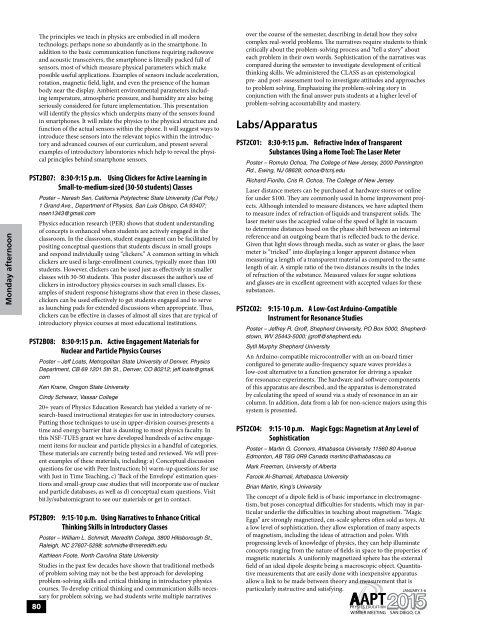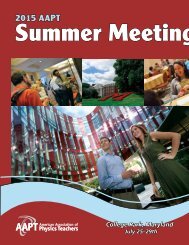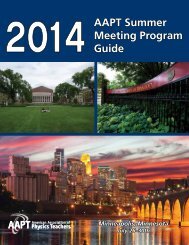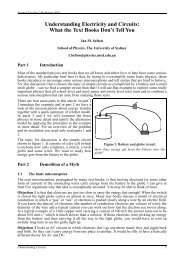final-program-12-23-14-3
final-program-12-23-14-3
final-program-12-23-14-3
Create successful ePaper yourself
Turn your PDF publications into a flip-book with our unique Google optimized e-Paper software.
Monday afternoon<br />
The principles we teach in physics are embodied in all modern<br />
technology, perhaps none so abundantly as in the smartphone. In<br />
addition to the basic communication functions requiring radiowave<br />
and acoustic transceivers, the smartphone is literally packed full of<br />
sensors, most of which measure physical parameters which make<br />
possible useful applications. Examples of sensors include acceleration,<br />
rotation, magnetic field, light, and even the presence of the human<br />
body near the display. Ambient environmental parameters including<br />
temperature, atmospheric pressure, and humidity are also being<br />
seriously considered for future implementation. This presentation<br />
will identify the physics which underpins many of the sensors found<br />
in smartphones. It will relate the physics to the physical structure and<br />
function of the actual sensors within the phone. It will suggest ways to<br />
introduce these sensors into the relevant topics within the introductory<br />
and advanced courses of our curriculum, and present several<br />
examples of introductory laboratories which help to reveal the physical<br />
principles behind smartphone sensors.<br />
PST2B07: 8:30-9:15 p.m. Using Clickers for Active Learning in<br />
Small-to-medium-sized (30-50 students) Classes<br />
Poster – Naresh Sen, California Polytechnic State University (Cal Poly,)<br />
1 Grand Ave., Department of Physics, San Luis Obispo, CA 93407;<br />
nsen1343@gmail.com<br />
Physics education research (PER) shows that student understanding<br />
of concepts is enhanced when students are actively engaged in the<br />
classroom. In the classroom, student engagement can be facilitated by<br />
positing conceptual questions that students discuss in small groups<br />
and respond individually using “clickers.” A common setting in which<br />
clickers are used is large-enrollment courses, typically more than 100<br />
students. However, clickers can be used just as effectively in smaller<br />
classes with 30-50 students. This poster discusses the author’s use of<br />
clickers in introductory physics courses in such small classes. Examples<br />
of student response histograms show that even in these classes,<br />
clickers can be used effectively to get students engaged and to serve<br />
as launching pads for extended discussions when appropriate. Thus,<br />
clickers can be effective in classes of almost all sizes that are typical of<br />
introductory physics courses at most educational institutions.<br />
PST2B08: 8:30-9:15 p.m. Active Engagement Materials for<br />
Nuclear and Particle Physics Courses<br />
Poster – Jeff Loats, Metropolitan State University of Denver, Physics<br />
Department, CB 69 <strong>12</strong>01 5th St., Denver, CO 802<strong>12</strong>; jeff.loats@gmail.<br />
com<br />
Ken Krane, Oregon State University<br />
Cindy Schwarz, Vassar College<br />
20+ years of Physics Education Research has yielded a variety of research-based<br />
instructional strategies for use in introductory courses.<br />
Putting those techniques to use in upper-division courses presents a<br />
time and energy barrier that is daunting to most physics faculty. In<br />
this NSF-TUES grant we have developed hundreds of active engagement<br />
items for nuclear and particle physics in a handful of categories.<br />
These materials are currently being tested and reviewed. We will present<br />
examples of these materials, including: a) Conceptual discussion<br />
questions for use with Peer Instruction; b) warm-up questions for use<br />
with Just in Time Teaching, c) ‘Back of the Envelope’ estimation questions<br />
and small-group case studies that will incorporate use of nuclear<br />
and particle databases, as well as d) conceptual exam questions. Visit<br />
bit.ly/subatomicgrant to see our materials or get in contact.<br />
PST2B09:<br />
9:15-10 p.m. Using Narratives to Enhance Critical<br />
Thinking Skills in Introductory Classes<br />
Poster – William L. Schmidt, Meredith College, 3800 Hillsborough St.,<br />
Raleigh, NC 27607-5298; schmidtw@meredith.edu<br />
Kathleen Foote, North Carolina State University<br />
Studies in the past few decades have shown that traditional methods<br />
of problem solving may not be the best approach for developing<br />
problem-solving skills and critical thinking in introductory physics<br />
courses. To develop critical thinking and communication skills necessary<br />
for problem solving, we had students write multiple narratives<br />
80<br />
over the course of the semester, describing in detail how they solve<br />
complex real-world problems. The narratives require students to think<br />
critically about the problem-solving process and “tell a story” about<br />
each problem in their own words. Sophistication of the narratives was<br />
compared during the semester to investigate development of critical<br />
thinking skills. We administered the CLASS as an epistemological<br />
pre- and post- assessment tool to investigate attitudes and approaches<br />
to problem solving. Emphasizing the problem-solving story in<br />
conjunction with the <strong>final</strong> answer puts students at a higher level of<br />
problem-solving accountability and mastery.<br />
Labs/Apparatus<br />
PST2C01:<br />
8:30-9:15 p.m. Refractive Index of Transparent<br />
Substances Using a Home Tool: The Laser Meter<br />
Poster – Romulo Ochoa, The College of New Jersey, 2000 Pennington<br />
Rd., Ewing, NJ 08628; ochoa@tcnj.edu<br />
Richard Fiorillo, Cris R. Ochoa, The College of New Jersey<br />
Laser distance meters can be purchased at hardware stores or online<br />
for under $100. They are commonly used in home improvement projects.<br />
Although intended to measure distances, we have adapted them<br />
to measure index of refraction of liquids and transparent solids. The<br />
laser meter uses the accepted value of the speed of light in vacuum<br />
to determine distances based on the phase shift between an internal<br />
reference and an outgoing beam that is reflected back to the device.<br />
Given that light slows through media, such as water or glass, the laser<br />
meter is “tricked” into displaying a longer apparent distance when<br />
measuring a length of a transparent material as compared to the same<br />
length of air. A simple ratio of the two distances results in the index<br />
of refraction of the substance. Measured values for sugar solutions<br />
and glasses are in excellent agreement with accepted values for these<br />
substances.<br />
PST2C02:<br />
9:15-10 p.m. A Low-Cost Arduino-Compatible<br />
Instrument for Resonance Studies<br />
Poster – Jeffrey R. Groff, Shepherd University, PO Box 5000, Shepherdstown,<br />
WV 25443-5000; jgroff@shepherd.edu<br />
Sytil Murphy Shepherd University<br />
An Arduino-compatible microcontroller with an on-board timer<br />
configured to generate audio-frequency square waves provides a<br />
low-cost alternative to a function generator for driving a speaker<br />
for resonance experiments. The hardware and software components<br />
of this apparatus are described, and the apparatus is demonstrated<br />
by calculating the speed of sound via a study of resonance in an air<br />
column. In addition, data from a lab for non-science majors using this<br />
system is presented.<br />
PST2C04: 9:15-10 p.m. Magic Eggs: Magnetism at Any Level of<br />
Sophistication<br />
Poster – Martin G. Connors, Athabasca University 11560 80 Avenue<br />
Edmonton, AB T6G 0R9 Canada martinc@athabascau.ca<br />
Mark Freeman, University of Alberta<br />
Farook Al-Shamali, Athabasca University<br />
Brian Martin, King’s University<br />
The concept of a dipole field is of basic importance in electromagnetism,<br />
but poses conceptual difficulties for students, which may in particular<br />
underlie the difficulties in teaching about magnetism. “Magic<br />
Eggs” are strongly magnetized, cm-scale spheres often sold as toys. At<br />
a low level of sophistication, they allow exploration of many aspects<br />
of magnetism, including the ideas of attraction and poles. With<br />
progressing levels of knowledge of physics, they can help illuminate<br />
concepts ranging from the nature of fields in space to the properties of<br />
magnetic materials. A uniformly magnetized sphere has the external<br />
field of an ideal dipole despite being a macroscopic object. Quantitative<br />
measurements that are easily done with inexpensive apparatus<br />
allow a link to be made between theory and measurement that is<br />
particularly instructive and satisfying.<br />
WINTER MEETING<br />
JANUARY 3-6<br />
2015<br />
SAN DIEGO, CA






